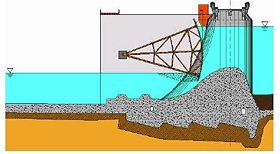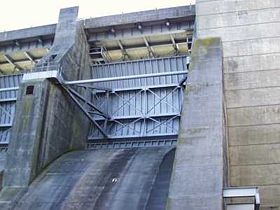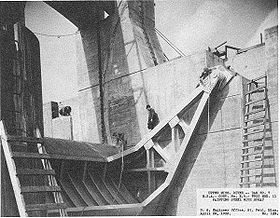
Tainter gate
Encyclopedia



Floodgate
Floodgates are adjustable gates used to control water flow in flood barriers, reservoir, river, stream, or levee systems. They may be designed to set spillway crest heights in dams, to adjust flow rates in sluices and canals, or they may be designed to stop water flow entirely as part of a levee or...
used in dam
Dam
A dam is a barrier that impounds water or underground streams. Dams generally serve the primary purpose of retaining water, while other structures such as floodgates or levees are used to manage or prevent water flow into specific land regions. Hydropower and pumped-storage hydroelectricity are...
s and canal locks to control water flow. It is named for Wisconsin
Wisconsin
Wisconsin is a U.S. state located in the north-central United States and is part of the Midwest. It is bordered by Minnesota to the west, Iowa to the southwest, Illinois to the south, Lake Michigan to the east, Michigan to the northeast, and Lake Superior to the north. Wisconsin's capital is...
structural engineer
Structural engineer
Structural engineers analyze, design, plan, and research structural components and structural systems to achieve design goals and ensure the safety and comfort of users or occupants...
Jeremiah Burnham Tainter
Jeremiah Burnham Tainter
Jeremiah Burnham Tainter was an inventor and engineer known for having designed the Tainter gate in 1886. He began his work in hydrology in 1862, with the modification of pre-existing mill pond dams in Menomonie.-References:*...
.
A side view of a Tainter gate resembles a slice of pie
Pie
A pie is a baked dish which is usually made of a pastry dough casing that covers or completely contains a filling of various sweet or savoury ingredients....
with the curved part of the piece facing the source or upper pool of water and the tip pointing toward the destination or lower pool. The curved face or skinplate of the gate takes the form of a wedge section of cylinder
Cylinder (geometry)
A cylinder is one of the most basic curvilinear geometric shapes, the surface formed by the points at a fixed distance from a given line segment, the axis of the cylinder. The solid enclosed by this surface and by two planes perpendicular to the axis is also called a cylinder...
. The straight sides of the pie shape, the trunnion
Trunnion
A trunnion is a cylindrical protrusion used as a mounting and/or pivoting point. In a cannon, the trunnions are two projections cast just forward of the centre of mass of the cannon and fixed to a two-wheeled movable gun carriage...
arms, extend back from each end of the cylinder section and meet at a trunnion which serves as a pivot point when the gate rotates.
Pressure forces acting on a submerged body act perpendicular to the body's surface. The design of the Tainter gate results in every pressure force acting through the centre of the imaginary circle which the gate is a section of, so that all resulting pressure force acts through the pivot point of the gate, making construction and design easier.
When a Tainter gate is closed, water bears on the convex (upstream) side. When the gate is rotated, the rush of water passing under the gate helps to open and close the gate. The rounded face, long radial arms and trunnion bearings
Trunnion
A trunnion is a cylindrical protrusion used as a mounting and/or pivoting point. In a cannon, the trunnions are two projections cast just forward of the centre of mass of the cannon and fixed to a two-wheeled movable gun carriage...
allow it to close with less effort than a flat gate. Tainter gates are usually controlled from above with a chain/gearbox/electric motor
Electric motor
An electric motor converts electrical energy into mechanical energy.Most electric motors operate through the interaction of magnetic fields and current-carrying conductors to generate force...
assembly.
A critical factor in Tainter gate design is the amount of stress transferred from the skinplate through the radial arms and to the trunnion and the resulting friction encountered when raising or lowering the gate. Some older systems have had to be modified to allow for frictional forces
Friction
Friction is the force resisting the relative motion of solid surfaces, fluid layers, and/or material elements sliding against each other. There are several types of friction:...
for which the original design did not plan.
The Tainter gate is used in water control dams and locks worldwide. The Upper Mississippi River
Upper Mississippi River
The Upper Mississippi River is the portion of the Mississippi River upstream of Cairo, Illinois, United States. From the headwaters at Lake Itasca, Minnesota, the river flows approximately 2000 kilometers to Cairo, where it is joined by the Ohio River to form the Lower Mississippi...
basin alone has 321 Tainter gates, and the Columbia River
Columbia River
The Columbia River is the largest river in the Pacific Northwest region of North America. The river rises in the Rocky Mountains of British Columbia, Canada, flows northwest and then south into the U.S. state of Washington, then turns west to form most of the border between Washington and the state...
basin has 195. A Tainter gate is also used to divert the flow of water to San Fernando Power Plant on the Los Angeles Aqueduct
Los Angeles Aqueduct
The Los Angeles Aqueduct system comprising the Los Angeles Aqueduct and the Second Los Angeles Aqueduct, is a water conveyance system operated by the Los Angeles Department of Water and Power...
. The Tainter gate was invented and first implemented in Menomonie, Wisconsin
Menomonie, Wisconsin
Two other spellings of the name appear elsewhere, see Menomonee and Menominee. For the town, see Menomonie .Menomonie is a city in and the county seat of Dunn County in the western part of the U.S. state of Wisconsin. The city's population was 16,264 as of the 2010 census...
.

